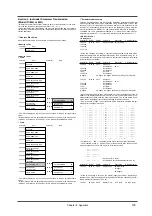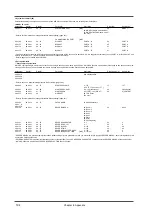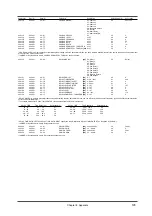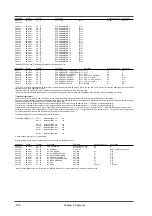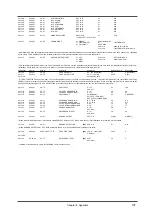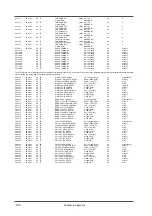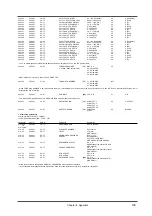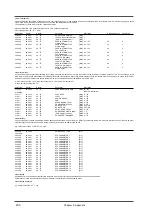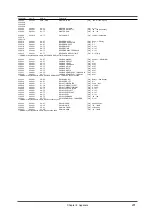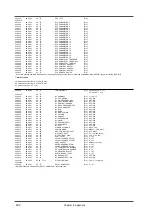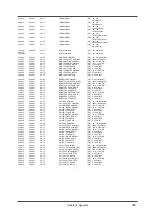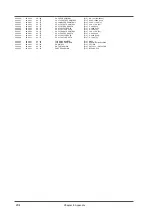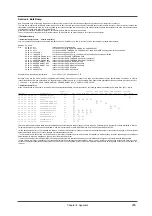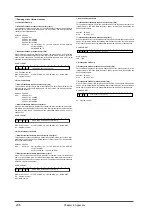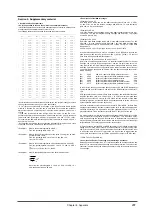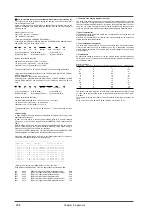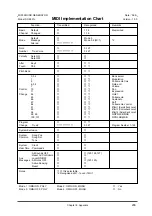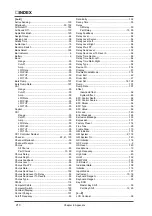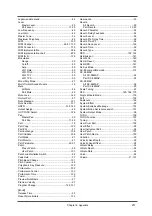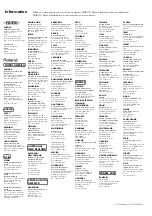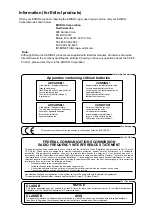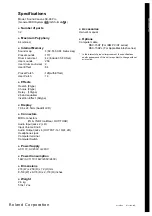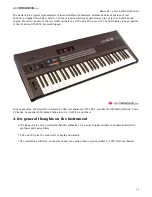
Chapter 8. Appendix
207
Section 5. Supplementary material
●
Decimal and Hexadecimal table
(An 'H' is appended to the end of numbers in hexadecimal notation.)
In MIDI documentation, data values and addresses/sizes of exclusive messages etc.
are expressed as hexadecimal values for each 7 bits.
The following table shows how these correspond to decimal numbers.
+-------+-------++-------+-------++-------+-------++-------+-------+
| Dec.| Hex.|| Dec.| Hex.|| Dec.| Hex.|| Dec.| Hex.|
+-------+-------++-------+-------++-------+-------++-------+-------+
| 0 | 00H || 32 | 20H || 64 | 40H || 96 | 60H |
| 1 | 01H || 33 | 21H || 65 | 41H || 97 | 61H |
| 2 | 02H || 34 | 22H || 66 | 42H || 98 | 62H |
| 3 | 03H || 35 | 23H || 67 | 43H || 99 | 63H |
| 4 | 04H || 36 | 24H || 68 | 44H || 100 | 64H |
| 5 | 05H || 37 | 25H || 69 | 45H || 101 | 65H |
| 6 | 06H || 38 | 26H || 70 | 46H || 102 | 66H |
| 7 | 07H || 39 | 27H || 71 | 47H || 103 | 67H |
| 8 | 08H || 40 | 28H || 72 | 48H || 104 | 68H |
| 9 | 09H || 41 | 29H || 73 | 49H || 105 | 69H |
| 10 | 0AH || 42 | 2AH || 74 | 4AH || 106 | 6AH |
| 11 | 0BH || 43 | 2BH || 75 | 4BH || 107 | 6BH |
| 12 | 0CH || 44 | 2CH || 76 | 4CH || 108 | 6CH |
| 13 | 0DH || 45 | 2DH || 77 | 4DH || 109 | 6DH |
| 14 | 0EH || 46 | 2EH || 78 | 4EH || 110 | 6EH |
| 15 | 0FH || 47 | 2FH || 79 | 4FH || 111 | 6FH |
| 16 | 10H || 48 | 30H || 80 | 50H || 112 | 70H |
| 17 | 11H || 49 | 31H || 81 | 51H || 113 | 71H |
| 18 | 12H || 50 | 32H || 82 | 52H || 114 | 72H |
| 19 | 13H || 51 | 33H || 83 | 53H || 115 | 73H |
| 20 | 14H || 52 | 34H || 84 | 54H || 116 | 74H |
| 21 | 15H || 53 | 35H || 85 | 55H || 117 | 75H |
| 22 | 16H || 54 | 36H || 86 | 56H || 118 | 76H |
| 23 | 17H || 55 | 37H || 87 | 57H || 119 | 77H |
| 24 | 18H || 56 | 38H || 88 | 58H || 120 | 78H |
| 25 | 19H || 57 | 39H || 89 | 59H || 121 | 79H |
| 26 | 1AH || 58 | 3AH || 90 | 5AH || 122 | 7AH |
| 27 | 1BH || 59 | 3BH || 91 | 5BH || 123 | 7BH |
| 28 | 1CH || 60 | 3CH || 92 | 5CH || 124 | 7CH |
| 29 | 1DH || 61 | 3DH || 93 | 5DH || 125 | 7DH |
| 30 | 1EH || 62 | 3EH || 94 | 5EH || 126 | 7EH |
| 31 | 1FH || 63 | 3FH || 95 | 5FH || 127 | 7FH |
+-------+-------++-------+-------++-------+-------++-------+-------+
* Decimal values such as MIDI channel, bank select, and program change are listed
as one greater than the values given in the above table.
* A 7-bit byte can express data in the range of 128 steps. For data where greater
precision is required, we must use two or more bytes. For example, two hexadeci-
mal numbers aa bbH expressing two 7-bit bytes would indicate a value of aa x
128+bb.
* In the case of values which have a
±
sign, 00H = -64, 40H =
±
0, and 7FH = +63,
so that the decimal expression would be 64 less than the value given in the above
chart. In the case of two types, 00 00H = -8192, 40 00H =
±
0, and 7F 7FH = +8191.
For example if aa bbH were expressed as decimal, this would be aa bbH - 40 00H =
aa x 128+bb - 64 x 128.
* Data marked "Use nibbled data" is expressed in hexadecimal in 4-bit units. A value
expressed as a 2-byte nibble 0a 0bH has the value of a x 16+b.
<Example 1>
What is the decimal expression of 5AH ?
From the preceding table, 5AH = 90
<Example 2>
What is the decimal expression of the value 12 34H given as hexa-
decimal for each 7 bits?
From the preceding table, since 12H = 18 and 34H = 52
18 x 128+52 = 2356
<Example 3>
What is the decimal expression of the nibbled value 0A 03 09 0D ?
From the preceding table, since 0AH = 10, 03H = 3, 09H = 9, 0DH =
13
((10 x 16+3) x 16+9) x 16+13 = 41885
<Example 4>
What is the nibbled expression of the decimal value 1258?
16) 1258
16) 78 ... 10
16) 4 ... 14
0 ... 4
Since from the preceding table, 0 = 00H, 4 = 04H, 14 = 0EH, 10 =
0AH, the answer is 00 04 0E 0AH.
●
Examples of actual MIDI messages
<Example 1> 92 3E 5F
9n is the Note-on status, and n is the MIDI channel number. Since 2H = 2, 3EH =
62, and 5FH = 95, this is a Note-on message with MIDI CH = 3, note number 62
(note name is D4), and velocity 95.
<Example 2> CE 49
CnH is the Program Change status, and n is the MIDI channel number. Since EH =
14 and 49H = 73, this is a Program Change message with MIDI CH = 15, program
number 74 (Flute in GS).
<Example 3> EA 00 28
EnH is the Pitch Bend Change status, and n is the MIDI channel number. The 2nd
byte (00H = 0) is the LSB and the 3rd byte (28H = 40) is the MSB, but Pitch Bend
Value is a signed number in which 40 00H (= 64 x 12+80 = 8192) is 0, so this Pitch
Bend Value is
28 00H - 40 00H = 40 x 12+80 - (64 x 12+80) = 5120 - 8192 = -3072
If the Pitch Bend Sensitivity is set to 2 semitones, -8192 (00 00H) will cause the
pitch to change -200 cents, so in this case -200 x (-3072)
÷
(-8192) = -75 cents of
Pitch Bend is being applied to MIDI channel 11.
<Example 4> B3 64 00 65 00 06 0C 26 00 64 7F 65 7F
BnH is the Control Change status, and n is the MIDI channel number. For Control
Changes, the 2nd byte is the control number, and the 3rd byte is the value. In a
case in which two or more messages consecutive messages have the same status,
MIDI has a provision called "running status" which allows the status byte of the sec-
ond and following messages to be omitted. Thus, the above messages have the fol-
lowing meaning.
B3
64 00
MIDI ch.4, lower byte of RPN parameter number
: 00H
(B3)
65 00
(MIDI ch.4) upper byte of RPN parameter number
: 00H
(B3)
06 0C
(MIDI ch.4) upper byte of parameter value
: 0CH
(B3)
26 00
(MIDI ch.4) lower byte of parameter value
: 00H
(B3)
64 7F
(MIDI ch.4) lower byte of RPN parameter number
: 7FH
(B3)
65 7F
(MIDI ch.4) upper byte of RPN parameter number
: 7FH
In other words, the above messages specify a value of 0C 00H for RPN parameter
number 00 00H on MIDI channel 4, and then set the RPN parameter number to 7F
7FH.
RPN parameter number 00 00H is Pitch Bend Sensitivity, and the MSB of the value
indicates semitone units, so a value of 0CH = 12 sets the maximum pitch bend
range to
±
12 semitones (1 octave). (On GS sound sources the LSB of Pitch Bend
Sensitivity is ignored, but the LSB should be transmitted anyway (with a value of 0)
so that operation will be correct on any device.)
Once the parameter number has been specified for RPN or NRPN, all Data Entry
messages transmitted on that same channel will be valid, so after the desired value
has been transmitted, it is a good idea to set the parameter number to 7F 7FH to
prevent accidents. This is the reason for the (B3) 64 7F (B3) 65 7F at the end.
It is not desirable for performance data (such as Standard MIDI File data) to contain
many events with running status as given in <Example 4>. This is because if play-
back is halted during the song and then rewound or fast-forwarded, the sequencer
may not be able to transmit the correct status, and the sound source will then misin-
terpret the data. Take care to give each event its own status.
It is also necessary that the RPN or NRPN parameter number setting and the value
setting be done in the proper order. On some sequencers, events occurring in the
same (or consecutive) clock may be transmitted in an order different than the order
in which they were received. For this reason it is a good idea to slightly skew the
time of each event (about 1 tick for TPQN = 96, and about 5 ticks for TPQN = 480).
* TPQN: Ticks Per Quarter Note
●
Example of an Exclusive message and calculating a Checksum
Roland Exclusive messages (RQ1, DT1) are transmitted with a checksum at the end
(before F7) to make sure that the message was correctly received. The value of the
checksum is determined by the address and data (or size) of the transmitted exclu-
sive message.
Summary of Contents for SoundCanvas SC-88 Pro
Page 9: ...Chapter 1 Try out the unit Quick start Chapter 1...
Page 18: ...Chapter 1 Try out the unit 16...
Page 19: ...Chapter 2 Parts and parameters Chapter 2...
Page 47: ...Chapter 3 System Effects Chapter 3...
Page 57: ...Chapter 4 Insertion Effects Chapter 4...
Page 97: ...Chapter 5 Convenient functions Chapter 5...
Page 121: ...Chapter 6 Using the unit with a personal computer Chapter 6...

